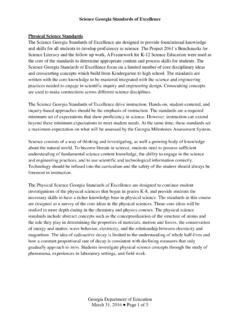Transcription of Net Zero Energy Roadmap for the ity of urlington, Vermont
1 Net zero Energy Roadmap for the City of Burlington, Vermont Prepared for the Burlington Electric Department September 5, 2019. Report Authors Synapse Energy Economics Resource Systems Group Jennifer Kallay Jonathan Slason Asa Hopkins, PhD Gabrielle Freeman Jason Frost David Grover Alice Napoleon Ben Swanson Kenji Takahashi Cover photo taken by Cathy Chamberlain: The City of Burlington, Vermont from the shores of Lake Champlain. CONTENTS. EXECUTIVE I. BACKGROUND .. 1. Drivers for the NZE by 2030 Goal .. 1. Burlington's Population and Infrastructure: Opportunities and Challenges .. 3. OVERVIEW OF THE ANALYSIS .. 6. Key Findings .. 6. Purpose and Scope .. 8. Overview of Scenarios, Pathways, and Sensitivities .. 9. Organization of the Report .. 11. A BUSINESS-AS-USUAL FUTURE .. 11. Description and Assumptions .. 11. Results .. 13. AN NZE BY 2030 FUTURE .. 16. Description and Assumptions .. 16. Results ..23. Supporting Strategies.
2 30. AN NZE BY 2040 FUTURE .. 45. Description and Assumptions ..45. Results .. 46. NEXT STEPS .. 49. EXECUTIVE SUMMARY. In 2018, Burlington, Vermont , announced the most ambitious climate goal established by any community in the United States to date. The City's Net zero Energy by 2030 (NZE by 2030) goal is defined as reducing and eventually eliminating fossil fuel use from the heating and ground transportation sectors. This NZE goal is ambitious for both its rapidity and comprehensiveness and will require holistic transformation. Reaching the goal will require a paradigm shift over the next decade including: Substantial reductions in Energy use through accelerated and integrated Energy efficiency in building thermal envelopes, equipment, appliances, lighting, and control systems, cultural and behavioral change around Energy use and distributed renewable 1 Energy resources serving buildings and community networks to shift increases in electricity usage to less expensive and less constrained times of the day.
3 A focus on equity in the design of every policy and program;. a rethinking of historic preservation to ensure every building that is renovated will provide an Energy efficient, comfortable, and healthy home or workspace;. comprehensive planning for every community construction project to ensure o policies allow for increased density in key locations;. o buildings are designed to be high performance2, compact, mixed-use and sited near places where residents work and recreate;. o redesign of roads to significantly increase multi-modal transportation; and, o increased focus on and investment in public transportation so it is more accessible, runs more frequently and is therefore better utilized;. rapid and widespread electrification of space heating, water heating, and transportation to completely cease fossil fuel Energy consumption;. continuation of Burlington Electric Department's practice of sourcing 100 percent of the City's electricity needs from renewables; and, stakeholder engagement including community, state, regional, and federal partners.
4 1 Renewable resources are those that are capable of being replaced by natural ecological cycles or sound management practices. 2 Includes Passive House and net zero standards. Net zero Energy Roadmap i As Burlington's municipal utility, Burlington Electric Department's (BED) Energy supply choices and service offerings are driven by and directly reflect its community's ambitions, priorities, and interests. In service to and collaboration with its community, BED contracted with Synapse Energy Economics (Synapse) and Resource Systems Group (RSG) to develop a Roadmap to provide clarity and insight into how the City could best achieve its goal. This Roadmap is a strategic analysis of the major steps or milestones needed to reach the goal with supporting data and recommended next steps for achieving the goal. The intended audience for this Roadmap is implementers including BED and partner organizations, city and state leaders as well as interested community members.
5 Caption: BED is aggressively transitioning its fleet of cars to electric vehicles. Photo by Burlington Electric Department. Synapse developed a business-as-usual (BAU) trajectory which confirmed that fossil fuels currently make up most of the Energy consumption in the Residential and Commercial building sector, and they account for almost all transportation Energy consumption. The building sector dominates Burlington's Energy consumption with 74 percent of total use. This Energy is mostly used for heating buildings; 95 percent of heating is supplied by natural gas, providing a formidable challenge as natural gas is already lower cost and cleaner than petroleum. The remaining Energy is used for vehicles and is almost exclusively petroleum. Net zero Energy Roadmap ii To achieve NZE by 2030, it will be essential to strategically power each of these sectors with renewable electricity or heat instead of fossil fuels while simultaneously reducing total Energy use through comprehensive Energy efficiency.
6 Figure ES 1 below shows the trajectory to achieve this goal. Figure ES 1: NZE by 2030 relative to the BAU. Figure ES 2 below shows the pathways, or tools, that Synapse's analysis illustrates Burlington must deploy to achieve its goal. Figure ES 2: Fossil fuel reductions by pathway Net zero Energy Roadmap iii CRITERIA FOR ACHIEVING NZE. Achieving NZE will require abiding by a set of important criteria. The following is a list of these criteria: 1. Use tools that are available today. No major technological breakthroughs are needed to meet the NZE goal. Fossil fuel Energy can be eliminated through more efficient and controlled equipment, fuel shifting, land use change, and social change. The tools or pathways Synapse analyzed to achieve this transformation are described in more detail below. 2. Deploy all the tools available. This report refers to the tools Burlington can use as pathways. No one pathway can get Burlington to its goal on its own.
7 While efficient electric buildings can get Burlington 60 percent towards its NZE by 2030 goal, Burlington will need to also pursue electric vehicles, a district Energy system, and alternative transport. 3. Enact a suite of strategies, each aggressive, to support each tool. It is important to note that BED is not advocating for any strategy or set of strategies in this report, but instead presenting strategies for consideration, discussion, and implementation through ongoing consultation with city and state leaders and community members. In the near term, the community needs to build the foundation for significant regulatory action and deploy significant amounts of capital in the form of incentives to fast-track implementation of solutions that are already in place today or well scoped. In the mid-term, regulatory action and financing, such as through a revenue bond, to cover any remaining customer costs becomes critical for getting to scale.
8 There are very few strategies that can be effective if only begun in the longer-term as the opportunity for substantial impact will have passed. Early replacement or buyout of equipment and replacing the remaining fossil fuel Energy use with renewable natural gas are two strategies that can be reasonably implemented during this 4. Design programs and policies to ensure new Energy demand does not occur during expensive constrained peak periods. Electrification of thermal and transportation Energy consumption leads to substantial increases in total electricity consumption. This increase in electricity consumption will require BED and its customers to acquire larger amounts of renewable electricity and invest in upgrades to existing distribution system infrastructure including individual distribution transformers, secondary conductors/cables, services, and customer- owned building wiring. To ensure the most positive economic outcome for ratepayers, it is necessary to avoid overlap between this new load and periods of high demand and high cost electricity as much as possible.
9 5. Recognize that time is short and valuable. Burlington needs to quickly implement an integrated suite of solutions and strategies to reach the goal, including changes in (1). governmental policies on zoning, permitting and building codes, (2) Energy benchmarking, and (3) transit infrastructure investment and planning. 3 Renewable natural gas is landfill gas, renewably-produced hydrogen or synthetic gas or some other renewably- produced gaseous fuel that can be used in place of natural gas. Net zero Energy Roadmap iv 6. Understand that regulation is necessary and can reduce costs. A singular focus on incentives to secure participation may be costly. Also, certain individuals may not decide to take advantage of program offerings. 7. Realize that equity must be achieved. All residents and businesses will need to be educated and engaged for this effort to be successful. This includes the vulnerable populations that may not be receiving equal services and resources today.
10 8. Value the environmental, economic, and social benefits. These include improved health, safety and air quality, better worker productivity due to increased comfort, and increased property value. Reaching a net zero Burlington by 2030 will require a transformation of the communities'. vehicles, transportation options, land use patterns and densities, and nearly every aspect of buildings that shapes Energy use: comprehensive weatherization, space and water heating, control systems, equipment, lighting, and appliances. While not every building needs to be net zero to achieve this goal, every building needs to be addressed in some way. With ample financial, technical, and regulatory supports, Efficient Electric Buildings . including comprehensive weatherization and electrification of space and water heating . represents the largest opportunity with 60 percent of total fossil fuel reductions. Increased adoption of Electric Vehicle technologies could deliver 20 percent of total fossil fuel reductions.





